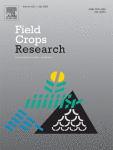Ver ítem
- xmlui.general.dspace_homeCentros Regionales y EEAsCentro Regional CórdobaEEA Marcos JuárezArtículos científicosxmlui.ArtifactBrowser.ItemViewer.trail
- Inicio
- Centros Regionales y EEAs
- Centro Regional Córdoba
- EEA Marcos Juárez
- Artículos científicos
- Ver ítem
Modelling water productivity for ecological intensification of crop sequences in the Inner Argentinean Pampas
Resumen
The design of crop sequences based on ecological intensification (EI) may help to restore lost agroecosystem services and to increase resource use efficiency. Our aim was to evaluate, using a modelling approach, the impact of EI-based strategies, such as changing crop sequence configuration and increasing cropping intensity and agrobiodiversity, in the Inner Argentinean Pampas (IAP) region on water productivity (WP) of crop sequences and its components,
[ver mas...]
The design of crop sequences based on ecological intensification (EI) may help to restore lost agroecosystem services and to increase resource use efficiency. Our aim was to evaluate, using a modelling approach, the impact of EI-based strategies, such as changing crop sequence configuration and increasing cropping intensity and agrobiodiversity, in the Inner Argentinean Pampas (IAP) region on water productivity (WP) of crop sequences and its components, i.e. water capture (Cw) and water use efficiency (WUE). We simulated crop sequences using SWB crop model for a 50-year period in two locations of IAP region. Crop sequences, of two-year duration each, had different configurations and included sole and/or double-crops in the growing season. These crop sequences were characterized using the following indexes of EI: cropping intensity index (CII), agrobiodiversity index (ABDI), cereal proportion (CP), maize (Zea mays L.) proportion (MP) and soybean (Glycine max [L] Merrill) proportion (SP). Our main findings reveal that: i) Regardless of location, all crop sequences alternatives to those based on a high SP had a higher estimated glucose yield, ii) Estimated glucose yield, WP, Cw, and WUE were significantly related to one or more indexes of EI included in multiple lineal models, iii) The role of Cw was more important than that of WUE to increase WP, iv) The choice of crop sequence was more critical to increase Cw when decreasing rainfall, v) vapour pressure deficit appears as a meteorological variable at least as important as the total amount of rainfall and its distribution pattern to design crop sequences in the IAP. Thus, the used modelling approach allowed us to evaluate crop sequences spanning a wide range of ecological intensification indexes, which take into account the level of agrobiodiversity, cropping intensity, and the proportion of key crops in their composition, gaining useful insights to design sustainable cropping systems.
[Cerrar]

Autor
Videla Mensegue, Horacio Rogelio;
Caviglia, Octavio;
Degioanni, Américo José;
Marcos, J.;
Bonadeo, E.;
Fuente
Field Crops Research 271 : 108246 (September 2021)
Fecha
2021-09
Editorial
Elsevier
ISSN
0378-4290
Documentos Relacionados
Formato
pdf
Tipo de documento
artículo
Proyectos
(ver más)
INTA/2019-PE-E1-I011-001/2019-PE-E1-I011-001/AR./Intensificacion Sustentable de la Agricultura en la Region Pampeana
INTA/2019-PE-E2-I041-001/2019-PE-E2-I041-001/AR./Aportes para la gestión integrada de los recursos hídricos (GIRH) en cuencas del Sistema Agroalimentario Argentino
INTA/2019-PE-E2-I042-001/2019-PE-E2-I042-001/AR./Uso y gestión eficiente del Agua en Sistemas de Secano
INTA/2019-PD-E2-I044-001/2019-PD-E2-I044-001/AR./Interacción de agroecosistemas y napas freáticas: innovaciones tecnológicas y organizacionales para su manejo a diferentes escalas.
Palabras Claves
Derechos de acceso
Restringido
 Excepto donde se diga explicitamente, este item se publica bajo la siguiente descripción: Creative Commons Attribution-NonCommercial-ShareAlike 2.5 Unported (CC BY-NC-SA 2.5)
Excepto donde se diga explicitamente, este item se publica bajo la siguiente descripción: Creative Commons Attribution-NonCommercial-ShareAlike 2.5 Unported (CC BY-NC-SA 2.5)

